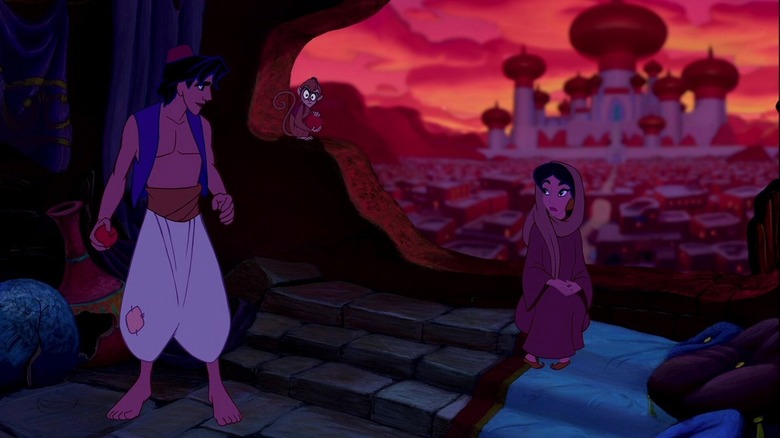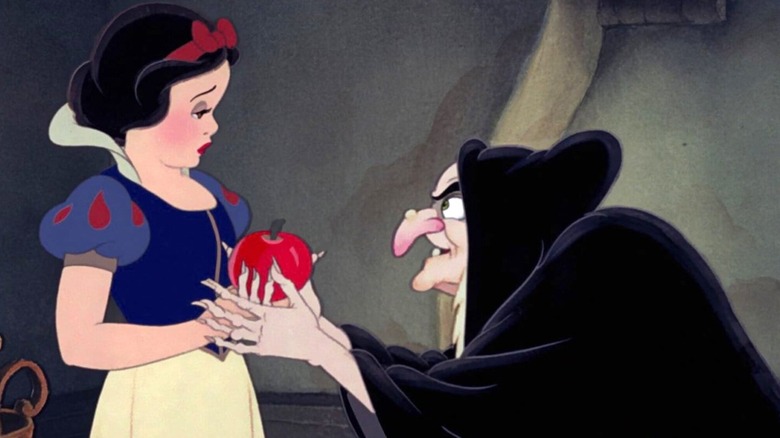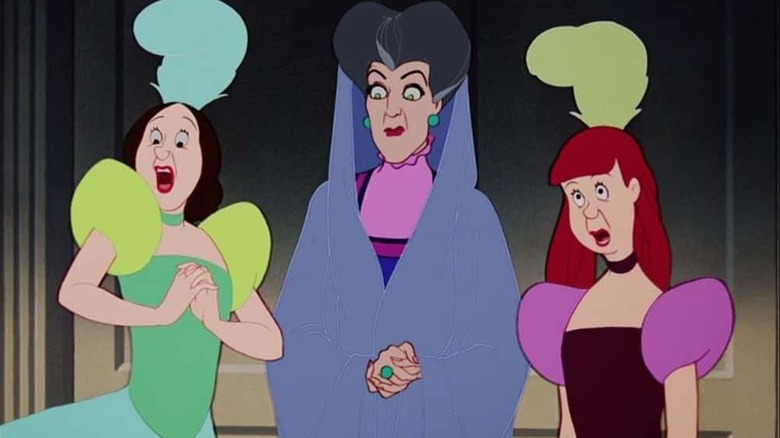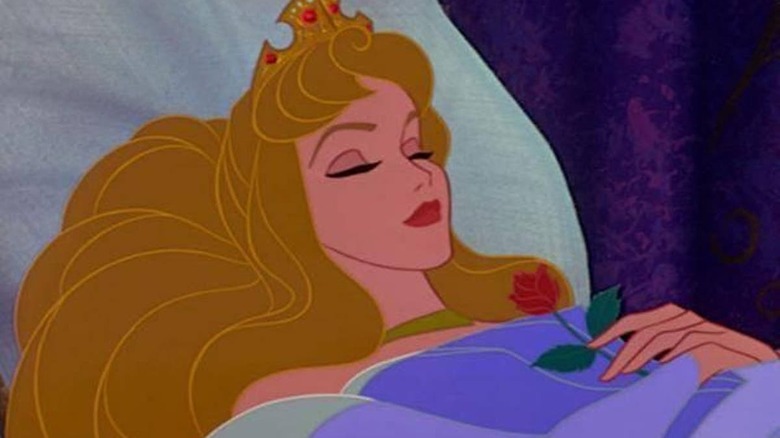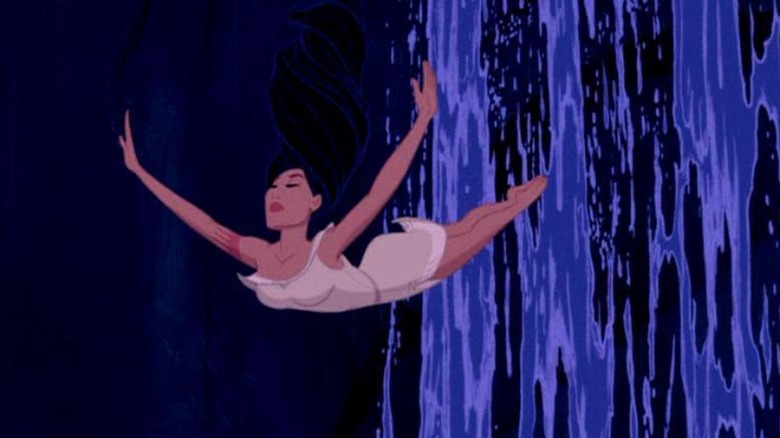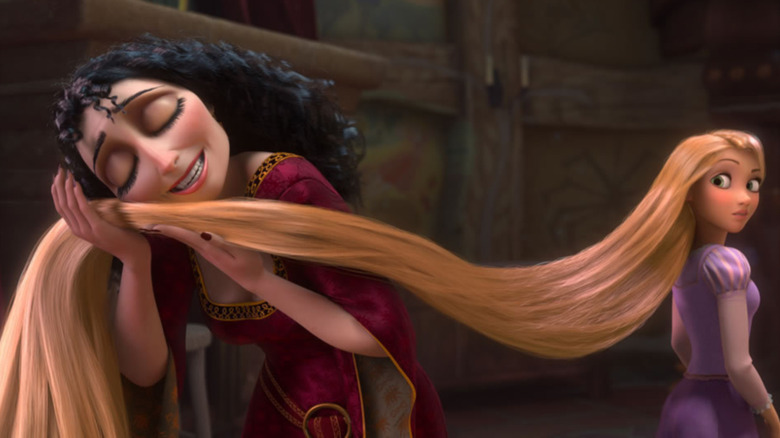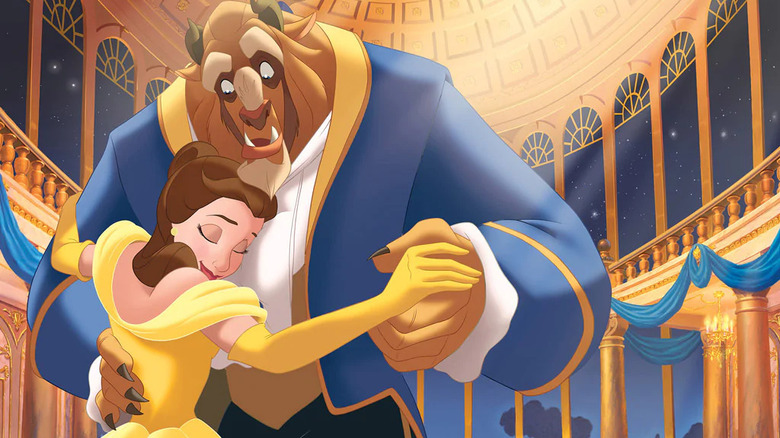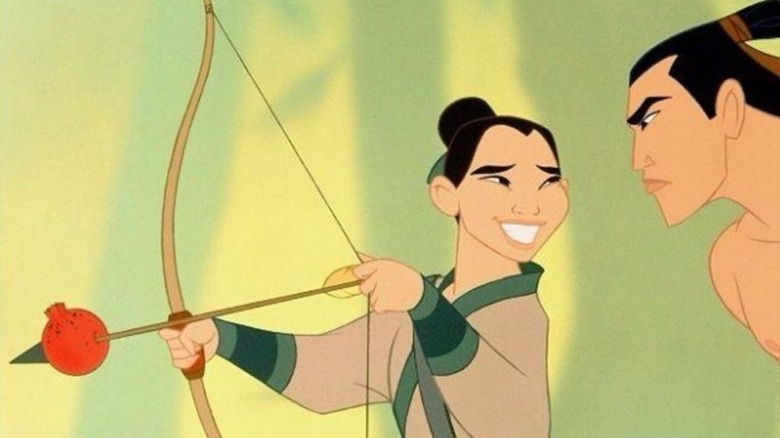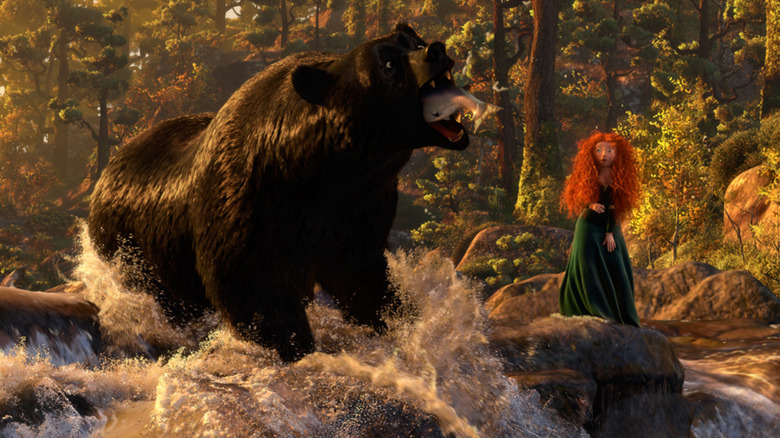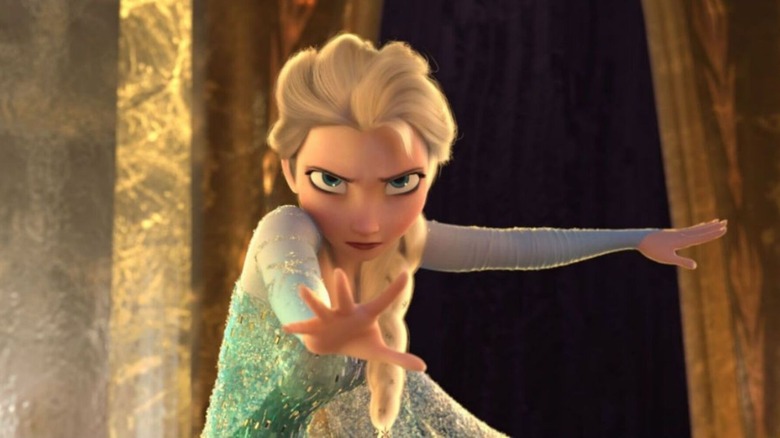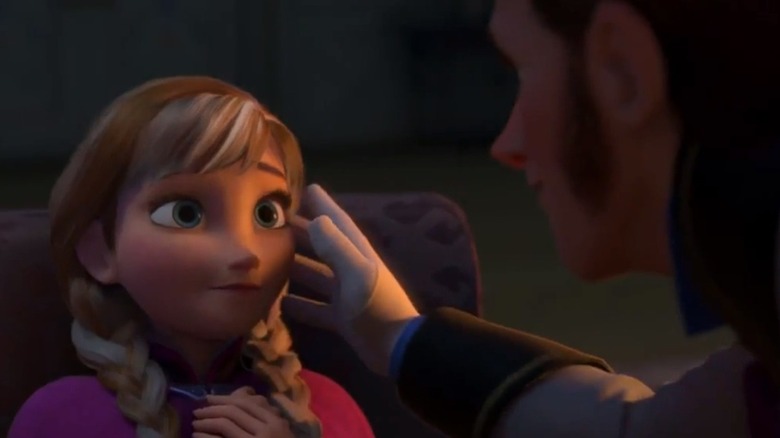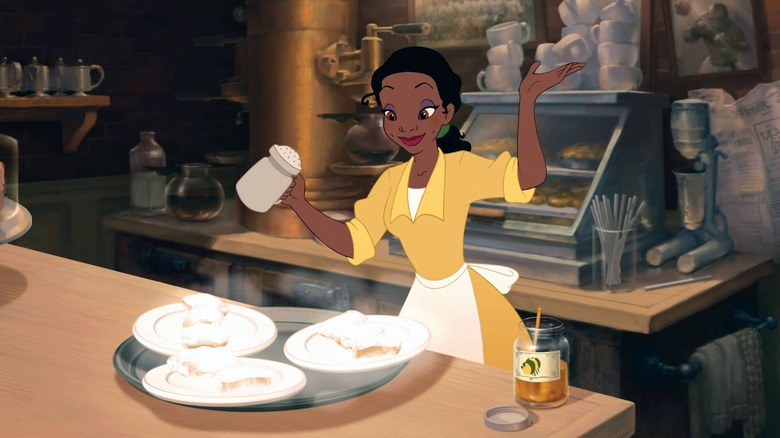The Worst Character Traits Of Each Disney Princess
Everyone knows what being a Disney princess means. Elegant. Beautiful. Virtuous. Great Singer. And quite often, hitched to a handsome prince. Ever since the release of Disney's 1937 animation classic "Snow White and the Seven Dwarfs," the Mouse House has rolled out a whole host of stories about princesses in fantastical settings, searching for their happily ever after.
Over time, the definition of what constitutes a "happily ever after" for a Disney Princess has evolved, and so their stories have evolved as well. While the earliest princesses were content to sleep it off in a tower while waiting for their prince to rescue them, modern princesses are much more practical about relying on their own strength and ingenuity to solve their problems.
But even today, the many Disney Princesses all follow a few general broad strokes for the "Disney-fied" versions of their fairy tales. On top of that, they bring their own unique flaws to the table as well — because let's be honest, without flaws to fix there would be no character growth. So, let's take a look at a few of the worst traits these princesses have displayed in their stories.
Jasmine has no sense of personal safety
1992's "Aladdin" introduced us to the film's titular character, an ordinary street hustler who dreams of marrying Princess Jasmine. But things are not so easy for the love birds as they must overcome class divides, lies, deceptions, and the machinations of the evil sorcerer Jafar.
While Jasmine is generally seen as one of the more proactive Disney Princesses, such behavior could be seen as reckless.
Rather than waiting around for a prince, Jasmine sneaks out of the palace at night to explore her city alone. This is against the well-considered advice of those around her — while it's understandable that Jasmine yearns for the open spaces of the city, away from rules, regulations, and the confines of her palace, such restrictions exist for a reason.
Imagine how easily things could have gone awry had she had not met Aladdin on her first night out alone in the city. It had been made clear that the streets were treacherous, and Jasmine could just as easily have been accosted by thugs and held hostage for a literal king's ransom. So in essence, she endangered her own life and her father's power, all so she could have a night out on the town.
Ariel is willing to give up her identity
1989's "The Little Mermaid" introduced audiences to Ariel, a mermaid with dreams of visiting the surface world. A chance meeting with the handsome Prince Eric convinces Ariel to use black magic granted by the villainous Ursula to change herself into a human girl and set out on a quest to win Eric's love.
That ... is just incredibly toxic behavior. One of the first rules of healthy relationships is that you should not have to change your personality to suit your partner. Here, Ariel is completely willing to change her entire species, on the off chance that the hot guy she met a couple of days ago might be into her too. For a woman who lives under water, she sure does seem thirsty.
What makes the whole thing even more questionable is that Ariel resorts to using black magic to undergo her transformation. How do we know its black magic? Because Ariel's wish to have legs is not given freely. It is part of a deal which says if Eric doesn't kiss her, her soul will forever belong to Ursula. In a Disney cartoon, Ariel's behavior can seem romantic because she ends up together with Eric. But in the original fairytale that inspired the Disney movie, things did not work out so well for naïve little Ariel.
Snow White is way too passive
For many, Snow White is the embodiment of the helpless Disney Princess trope — for good reason. The entirety of "Snow White and the Seven Dwarfs" is a study in Snow White's passivity. Sure, she is technically the main character, but the events of the movie happen "to" her rather than "because of" her.
For instance, her story begins when the Wicked Queen grows angry that Snow White is more beautiful. The Queen sends Snow White into the forest, along with a hunter who is charged with killing her — until he has a change of heart, telling Snow White to escape into the forest. There, she finds the dwarfs and lives with them for a bit, cooking and cleaning until the Witch poisons her. After lying, apparently dead, in a coffin, Snow White is awakened by true love's kiss from her prince and lives happily ever after alongside him.
In all those plot points, the onus was on other characters to either try to kill Snow White or save her. You could say Snow White is too young and inexperienced to handle these problems on her own, but that is exactly what modern Disney Princesses do. All in all, Snow White represents a type of Disney Princess that was accepted in her time, but today is mostly known for representing a need for the strong, independent Disney Princesses that would populate future films.
Cinderella can't stand up for herself
Cinderella is best remembered for her virtuous nature. Despite being mistreated daily by her wicked step mother and sisters, Cinderella always did everything they told her to, bore their insults, and was finally rewarded when the Prince chose her to be his bride over every other girl in the land.
In real life, things aren't so tidy, and allowing others to use you as a punching bag more often than not will end poorly. The only redemptive quality Cinderella had, it seems, was being born beautiful. Imagine if she had gone to the ball all dolled up and looking nice, and the Prince had decided to dance with someone else instead — what would happen then? She'd simply resign herself to being miserable the rest of her days?
If you're in a relationship — romantic, familial or otherwise — where the other person abuses you, belittles you, makes you do all the work, and never says or does anything nice for you, then you are in a toxic relationship and need to get out quickly.
Okay, Cinderella might be too young to understand that — but the Fairy Godmother isn't. She knew how badly Cinderella's family had treated her since childhood, but she still waited until Cindy was practically an adult before stepping in to help. Not exactly ideal behavior from the main characters of the story we're supposed to be rooting for.
Sleeping Beauty had stunted emotional growth
As far as sucky childhoods go, Princess Aurora of "Sleeping Beauty" could say "Mirror, mirror on the wall, whose upbringing was worst of all?"
On the day of her christening as an infant, Aurora was cursed by Maleficent to die on contact with the spindle of a spinning wheel. To mitigate the curse, Aurora's fairy godmothers changed "die" to "sleep until being awakened by true love's kiss."
To prevent further harm, the fairy godmothers took Aurora to live in isolation in the forest. So, Aurora grew up having virtually no contact with the outside world. Naturally, such an upbringing took its toll on the princess. Her emotional development was stunted due to a lack of interactions with people beyond her godmothers. Is it any wonder, then, that Aurora fell deeply in love with the first guy she ever met? She considered him her true love, even though she had absolutely no other male companionship to compare him against.
This being a Disney movie, things ended up working out, but it's a very poor worldview to encourage. In real life, it would be a bad idea to blindly accept that the first romantic possibility you met was destined to be your true love. Seriously Aurora, date a bit.
Pocahontas took unnecessary risks
In keeping with Disney Princess tradition, Pocahontas spends most of her time hanging out with animals instead of people her own age. Sure, she has friends in her tribe like Nakoma — but most of the time, Pocahontas is out in the wilds with her pet raccoon and hummingbird.
One negative trait of this time spent hanging with animals that are much more physically nimble than humans is that Pocahontas is an unnecessary thrill seeker. One of the first introductions we have to the character is watching her leap without any sort of protection from a dangerously high cliff, for no other reason than just adrenalized thrills.
Later, we see more examples of Pocahontas' reckless behavior when she goes out of her way to befriend the White settlers, despite the obvious dangers involved in such behavior. The sequel to "Pocahontas," in fact, acknowledged such dangerously impulsive behavior by showing Pocahontas maturing into a more calm, restrained person.
Rapunzel doesn't question authority
If one were to measure the march of women's rights against Disney Princess movies, an insightful glimpse into generational trends could be charted from the earliest movies (when being blindly obedient was considered the mark of a virtuous and good princess) to modern times (when Disney Princesses are expected to speak up and demand answers for their predicaments).
"Tangled" illustrates this entire journey using the character of Rapunzel. At first, the princess is blindly obedient to Mother Gothel. Despite her "mother" keeping her locked away in a tower for her entire childhood, Rapunzel never questions Gothel's actions. All Rapunzel can do is sing about how lonely and bored she is with the entire prison setup.
After she finally breaks free of the tower as a young adult, the years of stunted social growth make it clear that Rapunzel is not ready to handle the real world. You know, like the time she antagonized an entire pub full of thugs and bandits. If the scene in the pub had played out for real instead of in a Disney movie, it most likely would have ended much worse than the bandits performing a charming song-and-dance number about their dreams.
Belle might have Stockholm Syndrome
Many, many articles have been written about whether Belle from "Beauty and the Beast" is in a "Stockholm Syndrome" situation. The phenomenon, for those who don't know, occurs when a person in captivity develops an affinity towards their captor during their extended period of time together, often due to emotional brainwashing.
There is a strong case for those who say Belle suffers from Stockholm Syndrome. She clearly fears the Beast when they first meet. He is obviously holding her against her will, at least at first. Their eventual romance is also a direct result of the Beast and his friends plotting to make Belle love him, instead of something she independently chooses.
When Emma Watson signed on to play Belle in the live-action version of "Beauty and the Beast," she admitted to EW that it was a struggle at first to justify the relationship between Belle and the Beast. But the actress ultimately decided Belle does not have Stockholm Syndrome. "Belle actively argues and disagrees with [Beast] constantly," Watson explained. "She has none of the characteristics of someone with Stockholm Syndrome because she keeps her independence, she keeps that freedom of thought."
Mulan doesn't stand up for herself
Mulan is the most badass Disney Princess ever. Not only is she a skilled warrior, but she actually uses those skills to kill her enemies. Like, so, so many enemies. But before she became the most badass warrior in the emperor's army, Mulan had a real problem with standing up for herself.
Being the youngest in her family prior to joining the army, Mulan was often the butt of jokes within her own family. Things did not get better when she disguised herself as a man and joined the army. Much of Mulan's early days in the army had her being bullied by the other soldiers, particularly Ling and Yao.
A big part of Mulan's character arc had to do with her leaving her timid ways behind and gradually becoming more assertive. By the end of the film, Mulan finally stopped allowing other people to walk all over her, and became the legendary and fearless warrior who has ballads written about her.
Merida's recklessness hurt her loved ones
Before Elsa came into the picture, Princess Merida in "Brave" heralded the arrival of a new type of Disney Princess who relied on her own strength to deal with problems instead of waiting for a prince to rescue her. Unfortunately, Merida's independent nature was also pretty much the main source of problems in the movie.
After finding out her mother and father were going to get her married off, Merida plotted to get out of her royal obligations. She did this by making a deal with a witch that ended up turning her mother into a bear.
While her mother is the chief victim of Merida's recklessness, the fallout of her actions do not end there. The three main chiefs of the local tribes all declare war on one another, and the story almost ends with a great deal of bloodshed. In the end, it takes Merida learning to be a better person and putting the needs of the many before her own to undo her pact with the witch and save the kingdom from war.
Elsa doesn't trust anyone
If the makers of "Frozen" had gone ahead with their original plan to make Elsa the main villain of the story, this section of the article would be very long indeed. But in the end, the makers decided to turn Elsa into a heroine instead, and a superpowered one as well.
But as much as Elsa has done to show Disney Princesses in a powerful new light, she has also been the cause of much misery. Most of this has to do with her inability to trust others. Elsa's relationship with Anna suffered because Elsa refused to take her little sister into confidence regarding her ice powers.
Once Elsa's secret comes out, she runs away to once again live in isolation. Because of Elsa's refusal to have meaningful dialog with others, she remains unaware of the new ice age that she was unwittingly subjecting her kingdom to — or the fact that Anna and her subjects needed her help to deal with Hans' machinations.
Anna is way too trusting
If Elsa has a problem with trusting others, her little sister Anna has the opposite problem. In the beginning of "Frozen," it is shown that Anna has been starved of affection and attention because her parents refuse to tell her the truth about her sister, and Elsa refuses to play with her.
This rejection appears to have left a deep scar on Anna's psyche, and as a young adult, she frequently places herself in the most dangerous positions on the off-chance that she would find love. She is willing to fall in love with Prince Hans after knowing him only for a few hours. She is also willing to run off into the desolate countryside in search of her sister even after Elsa makes it clear that she wants to be left alone.
Both these actions come back to haunt Anna as Hans very nearly kills her, and she very nearly loses her life trying to get inside Elsa's castle. Even Anna's chance encounter with Kristoff, which quickly developed into friendship, could have ended badly if he had turned out to be untrustworthy or took advantage of her innocent nature and lack of ice powers.
Moana had major confidence issues
It might not seem like it at first glance, but Moana Waialiki might just be as powerful as Elsa in her own way. That is because Moana can become one with the oceans. But that power can only manifest itself when she learns to trust in herself — which reveal self-esteem struggles that threaten her throughout the movie.
While Moana is set from the start to become her tribe's new chieftain, she instead yearns to sail the seas freely. It is this central conflict that creates doubt in Moana's mind regarding her true destiny. Even after making the decision to head into the oceans to return the Heart of Te Fiti to its rightful place, Moana is plagued by indecisions that get in the way of her quest.
In the end, Moana is forced to realize that the only person who can define one's nature is oneself, not the sea or a tribe or any other external force. Once she understands this, Moana is finally able to put her doubts to rest, finding a way to unite her love for the seas with a love for her people.
Tiana works hard but is not a people person
"The Princess and the Frog" was different in many ways from traditional Disney Princess offerings. It's lead character Tiana was not a princess born and raised, but rather a 19-year-old workaholic waitress living in New Orleans in the 1920s. Naturally, this departure from tradition meant that Tiana's nature was quite different from the passive Snow White or obsequious Cinderella.
Coming from humble beginnings, Tiana had a more world-weary and cynical outlook than other Disney female leads. She could also be painfully blunt at times when a bit of tact would have done more good. After Ray tries to comfort Tiana when she thinks Naveen betrayed her, she lashes out at Ray instead, telling him that his beloved "Evangeline" is not a firefly, but rather a star in the sky that he will never be with.
Tiana's hardened edge also makes her slightly impatient with softer emotions. In the end, she has to learn that being good at your job and being a hard worker is not enough. To live a happy life, you also need to make time for friends and family.

